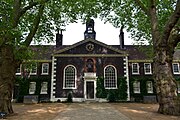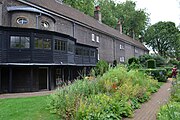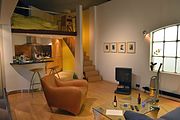Museum of the Home
 Museum façade | |
 Location of the Museum of the Home in London | |
| Established | 1914 |
|---|---|
| Location | Geffrye Almshouses 136 Kingsland Road London, E2 United Kingdom |
| Coordinates | 51°31′54″N 0°04′36″W / 51.531742°N 0.076630°W |
| Visitors | 120,000 (annually) |
| Director | Sonia Solicari |
| Public transit access | |
| Website | Museum of the Home |
The Museum of the Home, formerly the Geffrye Museum,[1] is a museum in the Geffrye Almshouses on Kingsland Road in Shoreditch, London. It explores home and home life from 1600 to the present day with a series of period room displays.[2] In 2018 the museum had about 120,000 visitors annually. It has a cafe, a learning pavilion, a collections library and an events space.
The museum is housed in 18th-century Grade I-listed former almshouses that for 200 years provided free housing to widows of ironmongers.[3] These were built in 1714 thanks to a bequest by Sir Robert Geffrye, a merchant who had served as Lord Mayor of London and Master of the Ironmongers' Company.[4] There were fourteen four room houses, for up to 56 pensioners, with a large garden. Sir Robert Geffery's Trust now has sheltered housing for 125 retired people of limited means in Hampshire.[5]
The Metropolitan Public Gardens Association contributed to the funding for the acquisition of the former almshouses and garden by Shoreditch Metropolitan Council, and the MPGA's landscape gardener Fanny Wilkinson laid out the garden in 1900–01.[6] In 1911 the Ironmongers' Company decided the area had become too dangerous for pensioners, moved them to the country, and sold the buildings to the London County Council (LCC), which opened the museum in 1914. When the LCC took over the site to create the Geffrye Museum, Wilkinson's design was replaced with a new layout. In 1992 a herb garden was opened on a formerly derelict site to the north of the building, partly funded again by the MPGA, which then awarded the herb garden its London Spade Award in 1992.[7] The museum became a charitable trust in 1991.[8]
The area was a centre of the furniture trade, so it was decided to establish a reference collection of furniture and interiors to inspire the manufactures. When furniture production moved away the museum focused on educating children.
Several structures connected with the museum are listed on the National Heritage List for England. The main museum building is Grade I listed and the niche in the northwest corner of the forecourt of the museum is listed Grade II*.[9][10] The forecourt wall, gates and railings to the museum are also Grade II* listed, and the two K6 telephone boxes on Kingsland Road outside the museum are listed Grade II.[11][12][13]
In January 2018, the museum closed for an £18m development project, reopening in June 2021.[14] Until this closure, the main permanent displays were a series of room settings furnished and decorated to show the main living spaces and elements of domestic life through the centuries, reflecting changes in society, behaviour, style and taste.[15] The museum's change of name was announced in 2019.[16] Since reopening, the Museum has new galleries to 'explore the concept of home through people’s everyday experiences of making, keeping and being at home over the last 400 years'.[17]
The building has above its entrance a statue of the benefactor who financed it, Robert Geffrye, a merchant whose wealth was partly derived from the forced labour and trading of enslaved Africans, a replica replacing the 1723 original which was moved to the new almshouses in 1912 when the building was sold.[8] In July 2020 the museum held a consultation on the potential removal of the statue, with public opinion being in favour of removing it. The museum's board elected instead to "reinterpret and contextualise" the statue in its current location,[18][19] under pressure from Culture Secretary Oliver Dowden.[20][21]
Gallery[]

The statue of Geffrye at the museum, after a 1723 original by John Nost

Front facade

Herb garden

Rear facade and garden

Garden reading room

Chapel

1870 drawing room

1998 loft apartment

20th Century galleries

Period gardens
References[]
- ^ Brown, Mark (27 November 2019). "Geffrye to reopen as Museum of the Home after £18m overhaul". The Guardian.
- ^ "Museum of the Home".
- ^ Haslam, Kathy (2005). A History of the Geffrye Almshouses. London: Geffrye Museum. ISBN 1872828108.
- ^ Hunting, Penelope (2013). Riot and Revolution: Sir Robert Geffery 1613–1704. London: Geffrye Museum. ISBN 1872828140.
- ^ "Charitable Trusts". Ironmongers' Company.
- ^ "London Gardens Trust: Geffrye Museum Gardens". Retrieved 19 January 2021.
- ^ "London Gardens Trust: Geffrye Museum Gardens". Retrieved 19 January 2021.
- ^ Jump up to: a b "Statement by the Board of Trustees of the Museum of the Home about the statue of Sir Robert Geffrye and plans to create greater diversity and representation at the Museum" (PDF). Museum of the Home. 29 July 2020. Retrieved 29 August 2020.
- ^ Historic England, "Niche in the north west corner of the forecourt of the museum (1265687)", National Heritage List for England, retrieved 5 July 2017
- ^ Historic England, "Geffrye Museum (1226772)", National Heritage List for England, retrieved 5 July 2017
- ^ Historic England, "Forecourt wall, gates and railings to the Geffrye Museum (1265688)", National Heritage List for England, retrieved 5 July 2017
- ^ Historic England, "K6 telephone kiosk, outside Geffrye Museum (1235680)", National Heritage List for England, retrieved 5 July 2017
- ^ Historic England, "K6 telephone kiosk, outside Geffrye Museum (1235681)", National Heritage List for England, retrieved 5 July 2017
- ^ "About the Museum". Museum of the Home.
- ^ "About the museum". Museum of the Home.
- ^ Sanderson, David (27 November 2019). "Tongue-twister Geffrye museum of the home clears its name". The Times.
- ^ "About the Museum". Museum of the Home.
- ^ York, Chris (30 June 2020). "'Black Lives Clearly Don't Matter' As Museum Ignores Public Vote And Keeps Slave Trader Statue". Huffington Post. Retrieved 29 August 2020.
- ^ "Museum of the Home to keep Sir Robert Geffrye statue". BBC News. 30 June 2020. Retrieved 29 August 2020.
- ^ Demianyk, Graeme (27 August 2020). "Museum Felt 'Extremely Compromised' By Minister's Plea To Keep Slave Trader Statue". Retrieved 29 August 2020.
- ^ "Dowden threatens to cut museum's funding if slave trader Sir Robert Geffrye's statue is removed". inews.co.uk. 6 October 2020. Retrieved 26 October 2020.
External links[]
| Wikimedia Commons has media related to Museum of the Home. |
Coordinates: 51°31′54.26″N 00°04′34.39″W / 51.5317389°N 0.0762194°W
- 1914 establishments in England
- Residential buildings completed in 1714
- Museums established in 1914
- Decorative arts museums in England
- Grade I listed buildings in the London Borough of Hackney
- Grade I listed almshouses
- Museums sponsored by the Department for Digital, Culture, Media and Sport
- Non-departmental public bodies of the United Kingdom government
- Museums in the London Borough of Hackney
- Art museums and galleries in London
- Musical instrument museums
- Shoreditch
- United Kingdom museum stubs










